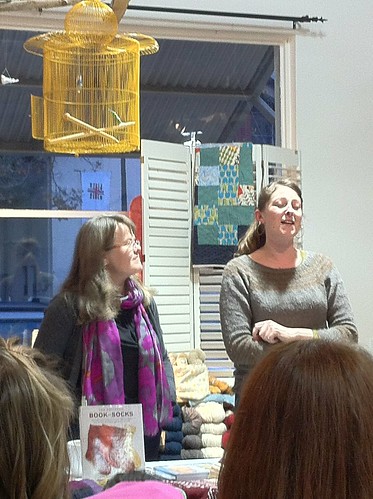Midterms are over, which means I have time to get back to knitting. After finishing Angostura, I remembered how much I like having just one knitting project on the needles at any time. But I wanted something quick, so I knit four hats. One-two-three-four, just like that. No photos yet, as they'll all likely end up as gifts. I was intent on finishing these hats, to quickly use up some stash and feel like I was making progress towards the gift list. Before I knew it, my favorite yarn/fabric/fiber store was celebrating their one-year anniversary. I was going to see and hear Clara Parkes, and I had nothing on the needles. I thought about casting on a sock (as would be appropriate), but I had no time. So a scarf it was.

That turned out to be a good idea, because it was packed at Verb and it was nice to not have a fiddly chart. The yarn was wonderfully soothing (and has continued to be so over this very busy week). It's two different skeins of handspun, one from the ancient depths of the stash and one from last year. The pattern is the good old Noro striped scarf. It was very low-distraction knitting, which I was grateful for during Clara's talk.

As I sit here writing this, I have to marvel that I've never blogged about Clara before. She's one of those people whose work you read, and it feels like you're chatting with a very smart, very old friend (old in the sense that you've known each other for a long time). I bought her first two books, The Knitter's Book of Yarn and The Knitter's Book of Wool during my first forays into spinning and fleece acquisition, respectively. I wanted to know how to construct my yarn so it would behave the way I wanted it to. The yarn book taught me a great deal about cellulose fibers, ply, twist, and density. The wool book sits on my shelf next to Beautiful Sheep, where the two books together provide endless entertainment as I imagine turning animal fluff into warm, cozy sweaters on these crisp evenings.
But the whole reason I learned how to spin was so that I could make my own sock yarn. Handspun socks. I've knit three pairs of socks out of handspun yarn, and I'd call one of them a definite success. The first pair of socks I knit out of handspun were for the husbeast. There, the problem was mostly that I wasn't very good at spinning fine yarn yet. They're more like felted slippers (very tight felted slippers) than socks, and they mostly get worn when it's very cold or on camping trips. The pattern was inspired by the basic sock in Cat Bordhi's first sock book, but with adjustments for gauge differences and a fancy cable running up the side. They're in the shape of socks, and they haven't gotten any holes yet, but they're not really comfortable for everyday wear.
The second pair that I made are awesome by accident. I was trying to get better at spinning yarn for socks, and I came across this amazing rainbow progression-dyed BFL fiber. I'd heard somewhere that BFL (which stands for Blue Faced Leicester, a breed of sheep) is good for socks. Now that I'm reflecting, I probably read it in the Knitter's Book of Wool. I had more than 8 ounces of fiber, and I knew I wanted rainbow socks. I figured out that the best way to do this would be to split the fiber into two long strips and chain-ply the yarn (chain plying is essentially doing a crochet chain where the loops are about as long as you can hold your arms while spinning and tensioning the singles). These socks came out great, the rainbow effect was lovely, but they're still a wee bit on the thick side.
Ironically, the most recent pair of handknit socks I've made are also the ones that have the most holes. Like two each. My handspun was probably not up to the task of being gently scrubbed between my foot and shoe for 8 hours a week. The fiber was super-soft, superwash merino. I'm about 20 pages into the Knitter's Book of Socks, and I now know that I should've spun this with socks in mind to begin with, or knit them at a tighter gauge.

Hearing Clara talk about her journey into the land of writing about knitting, what she loves about socks, the surprises she had while writing this most recent book, and her favorite breed of sheep and how she'd spin the wool for socks was a fantastic treat. Plus, we got to see the samples of all the socks from the book (Hello there, Shelter! I feel like we keep bumping into each other at these parties. Maybe we should get a cup of coffee soon, just the two of us... *wink wink, nudge nudge*).

At the end of the event, I was excited about socks in a way that I haven't been since 2007, when I signed up for the Blue Moon Fiber Arts Rockin' Sock Club. I'm excited about the science of socks, and the knitting of socks, and the wearing of socks. It's perfect project material for autumn. As soon as I finish the scarf.











No comments:
Post a Comment